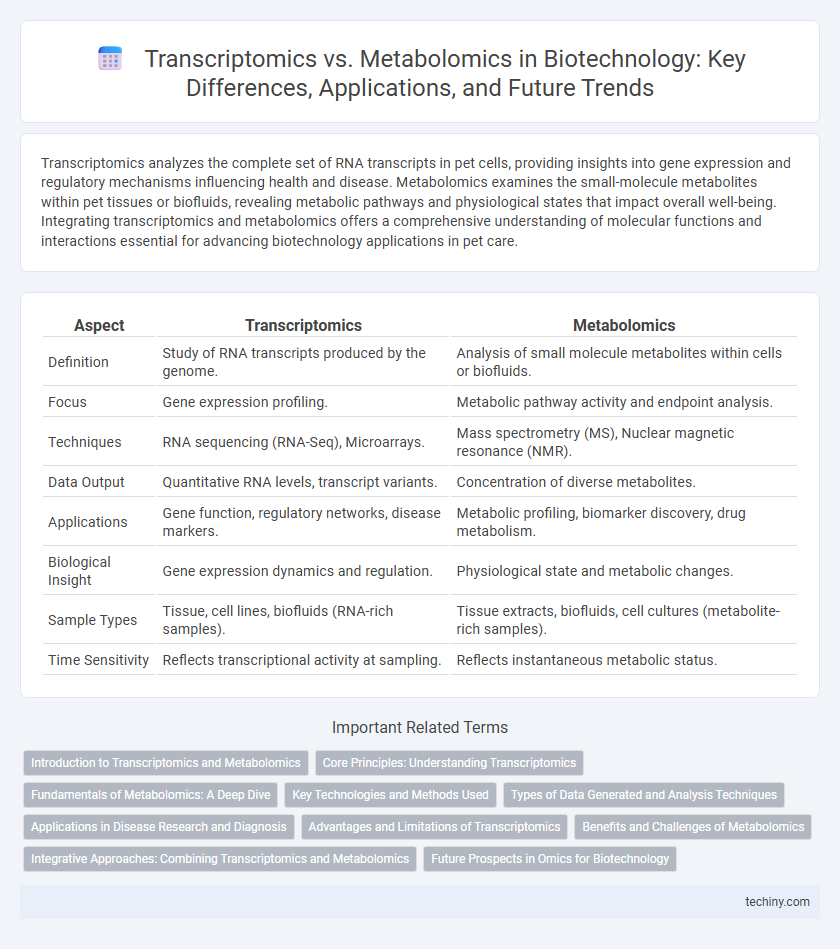Transcriptomics analyzes the complete set of RNA transcripts in pet cells, providing insights into gene expression and regulatory mechanisms influencing health and disease. Metabolomics examines the small-molecule metabolites within pet tissues or biofluids, revealing metabolic pathways and physiological states that impact overall well-being. Integrating transcriptomics and metabolomics offers a comprehensive understanding of molecular functions and interactions essential for advancing biotechnology applications in pet care.
Table of Comparison
| Aspect | Transcriptomics | Metabolomics |
|---|---|---|
| Definition | Study of RNA transcripts produced by the genome. | Analysis of small molecule metabolites within cells or biofluids. |
| Focus | Gene expression profiling. | Metabolic pathway activity and endpoint analysis. |
| Techniques | RNA sequencing (RNA-Seq), Microarrays. | Mass spectrometry (MS), Nuclear magnetic resonance (NMR). |
| Data Output | Quantitative RNA levels, transcript variants. | Concentration of diverse metabolites. |
| Applications | Gene function, regulatory networks, disease markers. | Metabolic profiling, biomarker discovery, drug metabolism. |
| Biological Insight | Gene expression dynamics and regulation. | Physiological state and metabolic changes. |
| Sample Types | Tissue, cell lines, biofluids (RNA-rich samples). | Tissue extracts, biofluids, cell cultures (metabolite-rich samples). |
| Time Sensitivity | Reflects transcriptional activity at sampling. | Reflects instantaneous metabolic status. |
Introduction to Transcriptomics and Metabolomics
Transcriptomics involves the comprehensive analysis of RNA transcripts produced by the genome under specific conditions, revealing gene expression patterns and regulatory mechanisms. Metabolomics focuses on the systematic identification and quantification of small-molecule metabolites within cells, tissues, or organisms, providing insights into biochemical activities and metabolic pathways. Both techniques offer complementary perspectives for understanding cellular functions and disease processes at different molecular levels.
Core Principles: Understanding Transcriptomics
Transcriptomics involves the study of the complete set of RNA transcripts produced by the genome under specific conditions, providing insights into gene expression and regulation. It utilizes techniques such as RNA sequencing (RNA-seq) and microarrays to quantify mRNA levels, revealing dynamic changes in cellular responses. Understanding transcriptomics is crucial for linking genotype to phenotype and identifying biomarkers in disease research and drug development.
Fundamentals of Metabolomics: A Deep Dive
Metabolomics involves the comprehensive analysis of metabolites, small molecule intermediates, and products of metabolism within cells, tissues, or organisms, providing a dynamic snapshot of physiological states. It focuses on identifying and quantifying metabolic profiles using technologies like mass spectrometry and nuclear magnetic resonance spectroscopy to reveal biochemical activities and pathways. Unlike transcriptomics, which examines gene expression at the RNA level, metabolomics directly reflects cellular phenotypes and metabolic responses to environmental or genetic changes.
Key Technologies and Methods Used
Transcriptomics primarily utilizes RNA sequencing (RNA-Seq) and microarray analysis to quantify and analyze gene expression profiles, enabling comprehensive insights into mRNA levels and alternative splicing events. Metabolomics relies on advanced technologies such as mass spectrometry (MS) and nuclear magnetic resonance (NMR) spectroscopy to identify and quantify metabolites, capturing dynamic biochemical changes within cells. Both fields employ high-throughput data acquisition and bioinformatics tools for data integration, yet transcriptomics focuses on transcript abundance while metabolomics maps metabolic pathways and fluxes.
Types of Data Generated and Analysis Techniques
Transcriptomics generates data on RNA expression levels, including mRNA, non-coding RNA, and microRNA sequences, primarily analyzed using RNA-Seq, microarrays, and quantitative PCR. Metabolomics produces comprehensive profiles of small-molecule metabolites within cells or biofluids, employing techniques such as mass spectrometry (MS), nuclear magnetic resonance (NMR) spectroscopy, and chromatography for data acquisition and interpretation. Advanced bioinformatics tools integrate both datasets for systems biology approaches, revealing functional insights and metabolic pathway activities.
Applications in Disease Research and Diagnosis
Transcriptomics enables the comprehensive analysis of gene expression patterns, facilitating the identification of disease biomarkers and understanding molecular mechanisms in conditions such as cancer, neurodegenerative disorders, and infectious diseases. Metabolomics provides detailed profiling of metabolic changes, offering insights into disease phenotypes, progression, and treatment responses by capturing real-time physiological states. Integrating transcriptomic and metabolomic data enhances precision medicine approaches, improving disease diagnosis accuracy and enabling personalized therapeutic strategies.
Advantages and Limitations of Transcriptomics
Transcriptomics provides a comprehensive analysis of gene expression, enabling the identification of active genes and regulatory pathways under specific conditions, which is crucial for understanding cellular responses and disease mechanisms. Its high-throughput RNA sequencing allows precise quantification of transcript levels, but it does not directly measure protein abundance or metabolic activity, limiting insights into post-transcriptional modifications and functional outcomes. Additionally, transcriptomic data can be influenced by RNA stability and processing, necessitating complementary methods like metabolomics for a holistic view of biological systems.
Benefits and Challenges of Metabolomics
Metabolomics offers comprehensive insights into cellular processes by profiling small-molecule metabolites, enabling precise biomarker discovery and disease diagnosis. This technique faces challenges such as high data complexity, variability in metabolite concentrations, and the need for advanced analytical platforms like mass spectrometry and nuclear magnetic resonance. Despite these hurdles, metabolomics enhances understanding of phenotype-genotype interactions and complements transcriptomics by revealing dynamic biochemical activities beyond gene expression.
Integrative Approaches: Combining Transcriptomics and Metabolomics
Integrative approaches combining transcriptomics and metabolomics enable comprehensive analysis of gene expression and metabolite profiles, revealing complex biological pathways and regulatory networks in biotechnology. By correlating transcriptomic data with metabolic changes, researchers can identify molecular mechanisms underlying phenotypic traits and disease states with higher precision. This multi-omics strategy accelerates biomarker discovery and enhances metabolic engineering for improved bioproduct synthesis.
Future Prospects in Omics for Biotechnology
Transcriptomics and metabolomics represent complementary omics technologies that accelerate advances in biotechnology by unraveling gene expression profiles and metabolite dynamics, respectively. Future prospects include integrating multi-omics data sets to enhance precision in metabolic engineering, biomarker discovery, and synthetic biology applications. Leveraging artificial intelligence and machine learning algorithms will optimize omics-driven biotechnological innovations for personalized medicine and sustainable bio-manufacturing.
Transcriptomics vs Metabolomics Infographic

 techiny.com
techiny.com